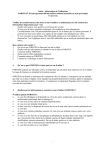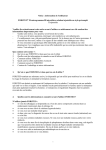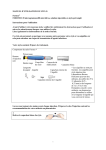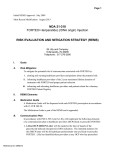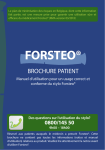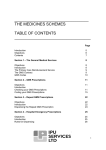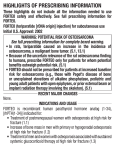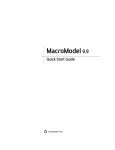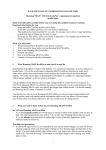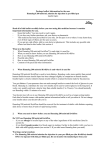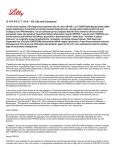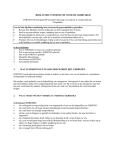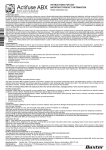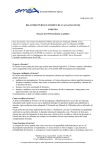Download FORSTEO, INN-teriparatide
Transcript
ANNEX I
SUMMARY OF PRODUCT CHARACTERISTICS
1.
NAME OF THE MEDICINAL PRODUCT
FORSTEO 20 micrograms/80 microliters solution for injection in pre-filled pen
2.
QUALITATIVE AND QUANTITATIVE COMPOSITION
Each dose contains 20 micrograms of teriparatide.
One pre-filled pen of 2.4 ml contains 600 micrograms of teriparatide (corresponding to 250
micrograms per ml).
Teriparatide, rhPTH(1-34), produced in E. coli, using recombinant DNA technology, is identical to the
34 N-terminal amino acid sequence of endogenous human parathyroid hormone.
For a full list of excipients, see section 6.1
3.
PHARMACEUTICAL FORM
Solution for injection in a pre-filled pen.
Colourless, clear solution.
4.
CLINICAL PARTICULARS
4.1
Therapeutic indications
Treatment of osteoporosis in postmenopausal women and in men at increased risk of fracture (see
section 5.1). In postmenopausal women, a significant reduction in the incidence of vertebral and nonvertebral fractures but not hip fractures has been demonstrated.
Treatment of osteoporosis associated with sustained systemic glucocorticoid therapy in women and
men at increased risk for fracture (see section 5.1).
4.2
Posology and method of administration
The recommended dose of FORSTEO is 20 micrograms administered once daily by subcutaneous
injection in the thigh or abdomen.
Patients must be trained to use the proper injection techniques (see section 6.6). A User Manual is also
available to instruct patients on the correct use of the pen.
The maximum total duration of treatment with FORSTEO should be 24 months (see section 4.4). The
24-month course of FORSTEO should not be repeated over a patient’s lifetime.
Patients should receive supplemental Calcium and vitamin D supplements if dietary intake is
inadequate.
Following cessation of FORSTEO therapy, patients may be continued on other osteoporosis therapies.
Use in renal impairment: FORSTEO should not be used in patients with severe renal impairment (see
4.3.). In patients with moderate renal impairment, FORSTEO should be used with caution.
Use in hepatic impairment: no data are available in patients with impaired hepatic function (see section
5.3).
2
Paediatric population and young adults with open epiphyses: There is no experience in paediatric
patients (less than 18 years). FORSTEO should not be used in paediatric patients (less than 18 years),
or young adults with open epiphyses.
Elderly patients: Dosage adjustment based on age is not required (see section 5.2).
4.3
Contraindications
•
•
•
•
•
Hypersensitivity to the active substance or to any of the excipients.
Pregnancy and lactation (see section 4.4 and 4.6)
Pre-existing hypercalcemia
Severe renal impairment
Metabolic bone diseases (including hyperparathyroidism and Paget’s disease of the bone) other
than primary osteoporosis or glucorticoid-induced osteoporosis.
Unexplained elevations of alkaline phosphatase
Prior external beam or implant radiation therapy to the skeleton
Patients with skeletal malignancies or bone metastases should be excluded from treatment with
teriparatide.
•
•
•
4.4
Special warnings and precautions for use
In normocalcemic patients, slight and transient elevations of serum calcium concentrations have been
observed following teriparatide injection. Serum calcium concentrations reach a maximum between 4
and 6 hours and return to baseline by 16 to 24 hours after each dose of teriparatide. Routine calcium
monitoring during therapy is not required.
Therefore if any blood samples are taken from a patient, this should be done at least 16 hours after the
most recent FORSTEO injection.
FORSTEO may cause small increases in urinary calcium excretion, but the incidence of hypercalciuria
did not differ from that in the placebo-treated patients in clinical trials.
FORSTEO has not been studied in patients with active urolithiasis. FORSTEO should be used with
caution in patients with active or recent urolithiasis because of the potential to exacerbate this
condition.
In short-term clinical studies with FORSTEO, isolated episodes of transient orthostatic hypotension
were observed. Typically, an event began within 4 hours of dosing and spontaneously resolved within
a few minutes to a few hours. When transient orthostatic hypotension occurred, it happened within the
first several doses, was relieved by placing subjects in a reclining position, and did not preclude
continued treatment.
Caution should be exercised in patients with moderate renal impairment.
Experience in the younger adult population, including premenopausal women, is limited (see section
5.1). Treatment should only be initiated if the benefit clearly outweighs risks in this population.
Women of childbearing potential should use effective methods of contraception during use of
FORSTEO. If pregnancy occurs, FORSTEO should be discontinued.
Studies in rats indicate an increased incidence of osteosarcoma with long-term administration of
teriparatide (see section 5.3). Until further clinical data become available, the recommended treatment
time of 24 months should not be exceeded.
4.5
Interactions with other medicinal products and other forms of interaction
3
FORSTEO has been evaluated in pharmacodynamic interaction studies with hydrochlorothiazide. No
clinically significant interactions were noted.
Co-administration of raloxifene or hormone replacement therapy with FORSTEO did not alter the
effects of FORSTEO on serum or urine calcium or on clinical adverse events.
In a study of 15 healthy subjects administered digoxin daily to steady state, a single FORSTEO dose
did not alter the cardiac effect of digoxin. However, sporadic case reports have suggested that
hypercalcemia may predispose patients to digitalis toxicity. Because FORSTEO transiently increases
serum calcium, FORSTEO should be used with caution in patients taking digitalis.
4.6
Fertility, pregnancy and lactation
General recommendation
Studies in rabbits have shown reproductive toxicity (see section 5.3). The effect of teriparatide on
human foetal development has not been studied. The potential risk for humans is unknown.
It is not known whether teriparatide is excreted in human milk.
FORSTEO is contraindicated for use during pregnancy or breast-feeding.
Women of childbearing potential / Contraception in females
Women of childbearing potential should use effective methods of contraception during use of
FORSTEO. If pregnancy occurs, FORSTEO should be discontinued.
4.7
Effects on ability to drive and use machines
No studies on the effects on the ability to drive and use machines have been performed. However,
transient, orthostatic hypotension or dizziness was observed in some patients. These patients should
refrain from driving or the use of machines until symptoms have subsided.
4.8
Undesirable effects
Of patients in the teriparatide trials, 82.8% of the FORSTEO patients and 84.5% of the placebo
patients reported at least 1 adverse event.
The most commonly reported adverse reactions in patients treated with FORSTEO are nausea, pain in
limb, headache and dizziness.
The undesirable reactions associated with the use of teriparatide in osteoporosis clinical trials and
post-marketing exposure are summarised in the table below. The following convention has been used
for the classification of the adverse reactions: very common ( ≥ 1/10), common (≥ 1/100 to <1/10),
uncommon (≥ 1/1,000 to <1/100), rare (≥ 1/10,000 to <1/1,000) very rare (<1/10,000), not known
(cannot be estimated from the available data).
4
Investigations
Uncommon: Weight increased, Cardiac murmur, alkaline phosphatase increase
Cardiac disorders
Common: Palpitations
Uncommon: Tachycardia
Blood and lymphatic system disorders
Common: Anaemia
Nervous system disorders
Common: Dizziness, Headache, Sciatica, Syncope
Ear and labyrinth disorders
Common: Vertigo
Respiratory, thoracic and mediastinal disorders
Common: Dyspnoea
Uncommon: Emphysema
Gastrointestinal disorders
Common: Nausea, Vomiting, Hiatus hernia, Gastroesophageal reflux disease
Uncommon: Haemorrhoids
Renal and urinary disorders
Uncommon: Urinary incontinence, Polyuria, Micturition urgency, Nephrolithiasis
Rare: Renal failure/impairment
Skin and subcutaneous tissue disorders
Common: Sweating increased
Musculoskeletal and connective tissue disorders
Very common: Pain in limb
Common: Muscle cramps
Uncommon: Myalgia, Arthralgia, Back cramp/pain*
Metabolism and nutrition disorders
Common: Hypercholesterolaemia
Uncommon: Hypercalcemia greater than 2.76 mmol/L, Hyperuricemia
Rare: Hypercalcemia greater than 3.25 mmol/L
Vascular disorders
Common: Hypotension
General disorders and administration site conditions
Common: Fatigue, Chest pain, Asthenia, Mild and transient injection site events, including pain,
swelling, erythema, localised bruising, pruritis and minor bleeding at injection site.
Uncommon: Injection site erythema, Injection site reaction
Rare: Possible allergic events soon after injection: acute dyspnoea, oro/facial oedema, generalised
urticaria, chest pain, oedema (mainly peripheral).
Psychiatric disorders
Common: Depression
*Serious cases of back cramp or pain have been reported within minutes of the injection.
In clinical trials the following reactions were reported at a ≥ 1% difference in frequency from placebo:
vertigo, nausea, pain in limb, dizziness, depression, dyspnoea.
FORSTEO increases serum uric acid concentrations. In clinical trials, 2.8% of FORSTEO patients
had serum uric acid concentrations above the upper limit of normal compared with 0.7% of placebo
patients. However, the hyperuricemia did not result in an increase in gout, arthralgia, or urolithiasis.
In a large clinical trial, antibodies that cross-reacted with teriparatide were detected in 2.8% of women
receiving FORSTEO. Generally, antibodies were first detected following 12 months of treatment and
diminished after withdrawal of therapy. There was no evidence of hypersensitivity reactions, allergic
reactions, effects on serum calcium, or effects on BMD response.
5
4.9
Overdose
Signs and symptoms
No cases of overdose were reported during clinical trials. FORSTEO has been administered in single
doses of up to 100 micrograms and in repeated doses of up to 60 micrograms/day for 6 weeks.
The effects of overdose that might be expected include delayed hypercalcaemia and risk of orthostatic
hypotension. Nausea, vomiting, dizziness, and headache can also occur.
Overdose experience based on post-marketing spontaneous reports:
In post-marketing spontaneous reports, there have been cases of medication error where the entire
contents (up to 800 μg) of the teriparatide pen have been administered as a single dose. Transient
events reported have included nausea, weakness/lethargy and hypotension. In some cases, no adverse
events occurred as a result of the overdose. No fatalities associated with overdose have been reported.
Overdose management:
There is no specific antidote for FORSTEO. Treatment of suspected overdose should include
transitory discontinuation of FORSTEO, monitoring of serum calcium, and implementation of
appropriate supportive measures, such as hydration.
5.
PHARMACOLOGICAL PROPERTIES
5.1
Pharmacodynamic properties
Pharmaco-therapeutic group: parathyroid hormones and analogues, ATC code: H05 AA02.
Mechanism of action:
Endogenous 84-amino-acid parathyroid hormone (PTH) is the primary regulator of calcium and
phosphate metabolism in bone and kidney. FORSTEO (rhPTH(1-34)) is the active fragment (1-34) of
endogenous human parathyroid hormone. Physiological actions of PTH include stimulation of bone
formation by direct effects on bone forming cells (osteoblasts) indirectly increasing the intestinal
absorption of calcium and increasing the tubular re-absorption of calcium and excretion of phosphate
by the kidney.
Pharmacodynamic effects
FORSTEO is a bone formation agent to treat osteoporosis. The skeletal effects of FORSTEO depend
upon the pattern of systemic exposure. Once-daily administration of FORSTEO increases apposition
of new bone on trabecular and cortical bone surfaces by preferential stimulation of osteoblastic
activity over osteoclastic activity.
Clinical efficacy
Risk Factors
Independent risk factors, for example, low BMD, age, the existence of previous fracture, family
history of hip fractures, high bone turnover and low body mass index should be considered in order to
identify women and men at increased risk of osteoporotic fractures who could benefit from treatment.
Premenopausal women with glucocorticoid-induced osteoporosis should be considered at high risk for
fracture if they have a prevalent fracture or a combination of risk factors that place them at high risk
for fracture (e.g., low bone density [e.g., T score ≤−2], sustained high dose glucocorticoid therapy
[e.g., ≥7.5 mg/day for at least 6 months], high underlying disease activity, low sex steroid levels).
Postmenopausal osteoporosis:
6
The pivotal study included 1637 postmenopausal women (mean age 69.5 years). At baseline, ninety
percent of the patients had one or more vertebral fractures, and on average, vertebral BMD was 0.82
g/cm2 (equivalent to a T-score = - 2.6). All patients were offered 1000 mg calcium per day and at least
400 IU vitamin D per day. Results from up to 24 months (median: 19 months) treatment with
FORSTEO demonstrate statistically significant fracture reduction (Table 1). To prevent one or more
new vertebral fractures, 11 women had to be treated for a median of 19 months.
Table 1
Fracture Incidence in Postmenopausal Women:
New vertebral
fracture (≥1) a
Multiple vertebral
fractures (≥2) a
Non-vertebral
fragility fractures c
Major non-vertebral
fragility fracturesc
(hip, radius, humerus,
ribs and pelvis)
Placebo
(N = 544) (%)
FORSTEO
(N = 541) (%)
14.3
5.0 b
4.9
1.1 b
5.5%
2.6% d
3.9%
1.5% d
Relative risk
(95% CI)
vs. placebo
0.35
(0.22, 0.55)
0.23
(0.09, 0.60)
0.47
(0.25, 0.87)
0.38
(0.17, 0.86)
Abbreviations: N = number of patients randomly assigned to each treatment group; CI = Confidence Interval.
a
The incidence of vertebral fractures was assessed in 448 placebo and 444 Forsteo patients who had baseline and follow-up
spine radiographs.
b
p≤0.001 compared with placebo
c
A significant reduction in the incidence of hip fractures has not been demonstrated
d
p≤0.025 compared with placebo.
After 19 months (median) treatment, bone mineral density (BMD) had increased in the lumbar spine
and total hip, respectively, by 9% and 4% compared with placebo (p<0.001).
Post-treatment management: Following treatment with FORSTEO, 1262 postmenopausal women from
the pivotal trial enrolled in a post-treatment follow-up study. The primary objective of the study was to
collect safety data of FORSTEO. During this observational period, other osteoporosis treatments were
allowed and additional assessment of vertebral fractures was performed.
During a median of 18 months following discontinuation of FORSTEO, there was a 41% reduction
(p=0.004) compared with placebo in the number of patients with a minimum of one new vertebral
fracture.
In an open-label study, 503 postmenopausal women with severe osteoporosis and a fragility fracture
within the previous 3 years (83% had received previous osteoporosis therapy) were treated with
FORSTEO for up to 24 months. At 24 months, the mean increase from baseline in lumbar spine, total
hip and femoral neck BMD was 10.5%, 2.6% and 3.9% respectively. The mean increase in BMD from
18 to 24 months was 1.4%, 1.2%, and 1.6% at the lumbar spine, total hip and femoral neck,
respectively.
Male osteoporosis:
437 patients (mean age 58.7 years) were enrolled in a clinical trial for men with hypogonadal (defined
as low morning free testosterone or an elevated FSH or LH) or idiopathic osteoporosis. Baseline spinal
7
and femoral neck bone mineral density mean T-scores were -2.2 and -2.1, respectively. At baseline,
35% of patients had a vertebral fracture and 59% had a non-vertebral fracture.
All patients were offered 1000 mg calcium per day and at least 400 IU vitamin D per day. Lumbar
spine BMD significantly increased by 3 months. After 12 months, BMD had increased in the lumbar
spine and total hip by 5% and 1%, respectively, compared with placebo. However, no significant
effect on fracture rates was demonstrated.
Glucocorticoid-induced osteoporosis
The efficacy of Forsteo in men and women (N=428) receiving sustained systemic glucocorticoid
therapy (equivalent to 5 mg or greater of prednisone for at least 3 months) was demonstrated in the 18month primary phase of a 36 month, randomised, double-blind, comparator-controlled study
(alendronate 10 mg/day). Twenty-eight percent of patients had one or more radiographic vertebral
fractures at baseline. All patients were offered 1000 mg calcium per day and 800 IU vitamin D per
day.
This study included postmenopausal women (N=277), premenopausal women (N=67), and men
(N=83). At baseline, the postmenopausal women had a mean age of 61 years, mean lumbar spine
BMD T score of −2.7, median prednisone equivalent dose of 7.5 mg/day, and 34% had one or more
radiographic vertebral fractures; premenopausal women had a mean age of 37 years, mean lumbar
spine BMD T score of −2.5, median prednisone equivalent dose of 10 mg/day, and 9% had one or
more radiographic vertebral fractures; and men had a mean age of 57 years, mean lumbar spine BMD
T score of −2.2, median prednisone equivalent dose of 10 mg/day, and 24% had one or more
radiographic vertebral fractures.
Sixty-nine percent of patients completed the 18-month primary phase. At the 18 month endpoint,
FORSTEO significantly increased lumbar spine BMD (7.2%) compared with alendronate (3.4%)
(p<0.001). FORSTEO increased BMD at the total hip (3.6%) compared with alendronate (2.2%)
(p<0.01), as well as at the femoral neck (3.7%) compared with alendronate (2.1%) (p<0.05). In
patients treated with teriparatide, lumbar spine, total hip and femoral neck BMD increased between 18
and 24 months by an additional 1.7%, 0.9%, and 0.4%, respectively.
At 36 months, analysis of spinal X-rays from 169 alendronate patients and 173 FORSTEO patients
showed that 13 patients in the alendronate group (7.7%) had experienced a new vertebral fracture
compared with 3 patients in the FORSTEO group (1.7%) (p=0.01). In addition, 15 of 214 patients in
the alendronate group (7.0%) had experienced a nonvertebral fracture compared with 16 of 214
patients in the FORSTEO group (7.5%) (p=0.84).
In premenopausal women, the increase in BMD from baseline to 18 month endpoint was significantly
greater in the FORSTEO group compared with the alendronate group at the lumbar spine (4.2% versus
−1.9%; p<0.001) and total hip (3.8% versus 0.9%; p=0.005). However, no significant effect on
fracture rates was demonstrated.
5.2
Pharmacokinetic properties
FORSTEO is eliminated through hepatic and extra-hepatic clearance (approximately 62 l/hr in women
and 94 l/hr in men). The volume of distribution is approximately 1.7 l/kg. The half-life of FORSTEO is
approximately 1 hour when administered subcutaneously, which reflects the time required for
absorption from the injection site. No metabolism or excretion studies have been performed with
FORSTEO but the peripheral metabolism of parathyroid hormone is believed to occur predominantly
in liver and kidney.
Patient characteristics:
Geriatrics
No differences in FORSTEO pharmacokinetics were detected with regard to age (range 31 to 85
years). Dosage adjustment based on age is not required.
8
5.3
Preclinical safety data
Teriparatide was not genotoxic in a standard battery of tests. It produced no teratogenic effects in rats,
mice or rabbits. There were no important effects observed in pregnant rats or mice administered
teriparatide at daily doses of 30 to 1000 µg/kg. However, fetal resorption and reduced litter size
occurred in pregnant rabbits administered daily doses of 3 to 100 µg/kg. The embryotoxicity observed
in rabbits may be related to their much greater sensitivity to the effects of PTH on blood ionised
calcium compared with rodents.
Rats treated with near-life time daily injections had dose-dependent exaggerated bone formation and
increased incidence of osteosarcoma most probably due to an epigenetic mechanism. Teriparatide did
not increase the incidence of any other type of neoplasia in rats. Due to the differences in bone
physiology in rats and humans, the clinical relevance of these findings is probably minor. No bone
tumours were observed in ovariectomised monkeys treated for 18 months or during a 3-year follow-up
period after treatment cessation. In addition, no osteosarcomas have been observed in clinical trials or
during the post treatment follow-up study.
Animal studies have shown that severely reduced hepatic blood flow decreases exposure of PTH to the
principal cleavage system (Kupffer cells) and consequently clearance of PTH(1-84).
6.
PHARMACEUTICAL PARTICULARS
6.1
List of excipients
Glacial acetic acid
Sodium acetate (anhydrous)
Mannitol
Metacresol
Hydrochloric acid
Sodium hydroxide
Water for injections
Hydrochloric acid and/or sodium hydroxide solution may be added to adjust pH.
6.2
Incompatibilities
In the absence of compatibility studies, this medicinal product must not be mixed with other medicinal
products.
6.3
Shelf life
2 years
Chemical, physical and microbiological in-use stability has been demonstrated for 28 days at 2-8°C.
Once opened, the product may be stored for a maximum of 28 days at 2°C to 8°C. Other in-use storage
times and conditions are the responsibility of the user.
6.4
Special precautions for storage
Store in a refrigerator (2°C – 8°C) at all times. The pen should be returned to the refrigerator
immediately after use. Do not freeze.
Do not store the injection device with the needle attached.
6.5
Nature and contents of container
9
2.4 ml solution in cartridge (siliconised Type I glass) with a plunger (halobutyl rubber), disc seal
(polyisoprene/bromobutyl rubber laminate)/aluminium assembled into a disposable pen.
FORSTEO is available in pack sizes of 1 or 3 pens. Each pen contains 28 doses of 20 micrograms (per
80 microliters).
Not all pack sizes may be marketed.
6.6
Special precautions for disposal
FORSTEO is supplied in a pre-filled pen. Each pen should be used by only one patient. A new, sterile
needle must be used for every injection. Each FORSTEO pack is provided with a user manual that
fully describes the use of the pen. No needles are supplied with the product. The device can be used
with insulin pen injection needles. After each injection, the FORSTEO pen should be returned to the
refrigerator.
FORSTEO should not be used if the solution is cloudy, coloured or contains particles.
Please also refer to the User Manual for instructions on how to use the pen.
Any unused product or waste material should be disposed of in accordance with local requirements.
7.
MARKETING AUTHORISATION HOLDER
Eli Lilly Nederland B.V, Grootslag 1-5, NL-3991 RA Houten, The Netherlands
8.
MARKETING AUTHORISATION NUMBER(S)
EU/1/03/247/001-002
9.
DATE OF FIRST AUTHORISATION/RENEWAL OF THE AUTHORISATION
Date of first authorisation: 10 June 2003.
Date of last renewal 10 June 2008
10.
DATE OF REVISION OF THE TEXT
10
ANNEX II
A.
MANUFACTURER OF THE BIOLOGICAL ACTIVE
SUBSTANCE AND MANUFACTURING AUTHORISATION
HOLDERS RESPONSIBLE FOR BATCH RELEASE
B.
CONDITIONS OF THE MARKETING AUTHORISATION
11
A.
MANUFACTURER OF THE BIOLOGICAL ACTIVE SUBSTANCE AND
MANUFACTURING AUTHORISATION HOLDERS RESPONSIBLE FOR BATCH
RELEASE
Name and address of the manufacturer of the biological active substance
Boehringer-Ingelheim RCV GmbH & Co KG, Dr.-Boehringer-Gasse 5-11, 1121 Vienna, Austria
Name and address of the manufacturers responsible for batch release
Lilly France S.A.S., rue du colonel Lilly, 67640 Fegersheim, France
The printed package leaflet of the medicinal product must state the name and address of the
manufacturer responsible for the release of the concerned batch.
B.
•
CONDITIONS OF THE MARKETING AUTHORISATION
CONDITIONS OR RESTRICTIONS REGARDING SUPPLY AND USE IMPOSED ON
THE MARKETING AUTHORISATION HOLDER
Medicinal product subject to medical prescription.
•
CONDITIONS OR RESTRICTIONS WITH REGARDS TO THE SAFE AND
EFFECTIVE USE OF THE MEDICINAL PRODUCT
Not applicable.
•
OTHER CONDITIONS
Pharmacovigilance system
The MAH must ensure that the system of pharmacovigilance, presented in Module 1.8.1. of the
Marketing Authorisation, is in place and functioning before and whilst the product is on the market.
The Marketing Authorisation Holder will submit PSURs annually.
Risk Management Plan
The MAH commits to performing the studies and additional pharmacovigilance activities detailed in
the Pharmacovigilance Plan, as agreed in the version n. 2.5 dated 17 January 2008 of the Risk
Management Plan (RMP) presented in Module 1.8.2. of the Marketing Authorisation and any
subsequent updates of the RMP agreed by the CHMP.
As per the CHMP Guideline on Risk Management Systems for medicinal products for human use, the
updated RMP should be submitted at the same time as the next Periodic Safety Update Report
(PSUR).
In addition, an updated RMP should be submitted:
• When new information is received that may impact on the current Safety Specification,
Pharmacovigilance Plan or risk minimisation activities
• Within 60 days of an important (pharmacovigilance or risk minimisation) milestone being
reached
• At the request of the European Medicines Agency
12
ANNEX III
LABELLING AND PACKAGE LEAFLET
13
A. LABELLING
14
PARTICULARS TO APPEAR ON THE OUTER PACKAGING
OUTER CARTON TEXT
1.
NAME OF THE MEDICINAL PRODUCT
FORSTEO 20 micrograms/80 microliters solution for injection in pre-filled pen
Teriparatide
2.
STATEMENT OF ACTIVE SUBSTANCE(S)
Each ml contains 250 micrograms of teriparatide.
3.
LIST OF EXCIPIENTS
Glacial acetic acid, sodium acetate (anhydrous), mannitol, metacresol 3.0 mg/ml (preservative), water
for injections. Hydrochloric acid solution and/or sodium hydroxide solution (as appropriate).
4.
PHARMACEUTICAL FORM AND CONTENTS
Solution for injection. 1 pen of 2.4 ml solution.
3 pens of 2.4 ml solution each.
Each pen contains 28 doses of 20 micrograms (per 80 microliters).
5.
METHOD AND ROUTE(S) OF ADMINISTRATION
Subcutaneous use
READ THE PACKAGE LEAFLET BEFORE USE
6.
SPECIAL WARNING THAT THE MEDICINAL PRODUCT MUST BE STORED OUT
OF THE REACH AND SIGHT OF CHILDREN
Keep out of the reach and sight of children.
7.
OTHER SPECIAL WARNING(S), IF NECESSARY
To open, lift here and pull.
8.
EXPIRY DATE
EXP {MM/YYYY}
The pen should be discarded 28 days after the first use.
Date of first use:
9.
SPECIAL STORAGE CONDITIONS
15
Store in a refrigerator.
Do not freeze.
10.
SPECIAL PRECAUTIONS FOR DISPOSAL OF UNUSED MEDICINAL PRODUCTS
OR WASTE MATERIALS DERIVED FROM SUCH MEDICINAL PRODUCTS, IF
APPROPRIATE
11.
NAME AND ADDRESS OF THE MARKETING AUTHORISATION HOLDER
Eli Lilly Nederland B.V.
Grootslag 1-5, NL-3991 RA Houten
The Netherlands
12.
MARKETING AUTHORISATION NUMBER(S)
EU/1/03/247/001
Or
EU/1/03/247/002
13.
BATCH NUMBER
Lot
14.
GENERAL CLASSIFICATION FOR SUPPLY
Medicinal product subject to medical prescription.
15.
INSTRUCTIONS ON USE
16.
INFORMATION IN BRAILLE
FORSTEO
16
MINIMUM PARTICULARS TO APPEAR ON SMALL IMMEDIATE PACKAGING UNITS
LABEL TEXT
1.
NAME OF THE MEDICINAL PRODUCT AND ROUTE(S) OF ADMINISTRATION
FORSTEO 20 micrograms/80 microliters, solution for injection in pre-filled pen
Teriparatide
Subcutaneous use
2.
METHOD OF ADMINISTRATION
Read the package leaflet before use.
3.
EXPIRY DATE
Exp. {MM/YYYY}
4.
BATCH NUMBER
Lot
5.
CONTENTS BY WEIGHT, BY VOLUME OR BY UNIT
2.4 ml
6.
OTHER
Store in a refrigerator
17
B. PACKAGE LEAFLET
18
PACKAGE LEAFLET: INFORMATION FOR THE USER
FORSTEO 20 micrograms/80 microliters solution for injection in pre-filled pen
Teriparatide
Read all of this leaflet carefully before you start using this medicine.
- Keep this leaflet. You may need to read it again.
- If you have any further questions, ask your doctor or pharmacist.
- This medicine has been prescribed for you. Do not pass it on to others. It may harm them, even if
their symptoms are the same as yours.
- If any of the side effects gets serious, or if you notice any side effects not listed in this leaflet,
please tell your doctor or pharmacist.
In this leaflet:
1.
What FORSTEO is and what it is used for
2.
Before you use FORSTEO
3.
How to use FORSTEO
4.
Possible side effects
5
How to store FORSTEO
6.
Further information
1.
WHAT FORSTEO IS AND WHAT IT IS USED FOR
FORSTEO is used to make the bones stronger, and to reduce the risk of fractures (bone-formation
agent).
This product is used to treat osteoporosis. Osteoporosis is a disease that causes your bones to become
thin and fragile. This disease is especially common in women after the menopause, but it can also
occur in men. Osteoporosis is also common in patients receiving corticosteroids.
2.
BEFORE YOU USE FORSTEO
Do not use FORSTEO
•
if you are allergic (hypersensitive) to teriparatide or any of the other ingredients of FORSTEO.
•
if you suffer from high calcium levels (pre-existing hypercalcaemia).
•
if you suffer from serious kidney problems.
•
if you have ever been diagnosed with bone cancer or other cancers that have spread
(metastasised) to your bones.
•
if you have certain bone diseases. If you have a bone disease, tell your doctor.
•
if you have unexplained high levels of alkaline phosphatase in your blood, which means
you might have Paget’s disease. If you are not sure, ask your doctor.
•
if you have had radiation therapy involving your bones.
•
if you are pregnant or breast-feeding.
FORSTEO should not be used in children (less than 18 years) or in growing adults.
Take special care with FORSTEO
FORSTEO may cause an increase in the amount of calcium in your blood. Tell your doctor if you
have continuing nausea, vomiting, constipation, low energy, or muscle weakness. These may be signs
there is too much calcium in your blood.
FORSTEO may cause an increase in the amount of calcium in your urine. You should tell your doctor
if you suffer from kidney stones or have a history of kidney stones.
You should tell your doctor if you suffer from kidney problems (moderate renal impairment).
19
Some patients get dizzy or get a fast heartbeat after the first few doses. For the first doses, inject
FORSTEO where you can sit or lie down right away if you get dizzy.
The recommended treatment time of 24 months should not be exceeded.
Taking other medicines
Please tell your doctor or pharmacist if you are taking or have recently taken any other medicines,
including medicines obtained without a prescription, because occasionally they may interact (e.g.
digoxin/digitalis, a medicine used to treat heart disease).
Using FORSTEO with food and drink
Forsteo can be given with or without food.
Pregnancy and breast-feeding
Do not use FORSTEO if you are pregnant or breast-feeding. Women of child-bearing potential should
use effective methods of contraception during use of FORSTEO. If pregnancy occurs, FORSTEO
should be discontinued. Ask your doctor or pharmacist for advice before taking any medicine.
Driving and using machines
Some patients may feel dizzy after injecting FORSTEO. If you feel dizzy you should not drive or use
machines until you feel better.
Important information about some of the ingredients of FORSTEO:
This medicinal product contains less than 1 mmol sodium (23 mg) per dose. This means that it is
essentially “sodium-free”.
3.
HOW TO USE FORSTEO
Always use FORSTEO exactly as your doctor has told you to. You should check with your doctor or
pharmacist if you are not sure.
Never share your FORSTEO pen with others
The recommended dose of FORSTEO is 20 micrograms given once daily by injection under the skin
(subcutaneous injection) in the thigh or abdomen. To help you remember to take FORSTEO, inject it
at about the same time each day.
Inject FORSTEO each day for as long as your doctor prescribes it for you. The total duration of
treatment with FORSTEO should not exceed 24 months. You should not receive more than one
treatment course of 24 months over your lifetime.
FORSTEO can be injected at meal times.
Read the user manual booklet, which is included in the carton for instructions on how to use the
FORSTEO pen.
Injection needles are not included with the pen. You can use Becton Dickinson and Company’s insulin
pen injection needles.
You should take your FORSTEO injection shortly after you take the pen out of the refrigerator as
described in the user manual. Put the pen back into the refrigerator immediately after you have used it.
Use a new injection needle for each injection and dispose of it after each use. Never store your pen
with the needle attached.
Your doctor may advise you to take FORSTEO with calcium and vitamin D. Your doctor will tell you
how much you should take each day.
If you use more FORSTEO than you should
If, by mistake, you have used more FORSTEO than you should, contact your doctor or pharmacist.
20
The effects of overdose that might be expected include nausea, vomiting, dizziness, and headache.
If you forget or cannot take FORSTEO at your usual time, take it as soon as possible on that day.
Do not take a double dose to make up for a forgotten dose. Do not take more than one injection in the
same day. Do not try to make up for a missed dose.
If you have any further questions on the use of this product, ask your doctor or pharmacist.
4.
POSSIBLE SIDE EFFECTS
Like all medicines, FORSTEO can cause side effects, although not everybody gets them.
The most common side effects (affects more than 1 user in 10) are:
• pain in limb.
Common side effects (1 to 10 users in 100) are:
• feeling sick,
• headache
• dizziness
• increase in blood cholesterol levels
• depression
• neuralgic pain in the leg
• feeling faint
• irregular heart beats
• breathlessness
• increased sweating
• muscle cramps
• loss of energy
• tiredness
• chest pain
• low blood pressure,
• heartburn (painful or burning sensation just below the breast bone),
• low haemoglobin or red blood cell count (anaemia).
Uncommon side effects (affects 1 to 10 users in 1000) are:
• increased heart rate,
• shortness of breath,
• haemorrhoids (piles),
• accidental loss or leakage of urine,
• increased need to pass water,
• weight increase
• kidney stones.
Other uncommon side effects reported include pain in the muscles and pain in the joints.
Some people may experience discomfort such as redness of the skin, pain, swelling, itching, bruising
or minor bleeding around the area of the injection. This should clear up in a few days or weeks.
Otherwise tell your doctor as soon as possible.
If you become dizzy (light-headed) after your injection, you should sit or lie down until you feel
better. If you do not feel better, you should call a doctor before you continue treatment. Cases of
fainting have been reported in association with teriparatide use.
21
Some patients treated with FORSTEO have had an increase in their blood calcium level.
Rare side effects (affects 1 to 10 users in 10,000): Some patients have experienced allergic reactions
soon after injection, consisting of breathlessness, swelling of the face, rash and chest pain.
Cases of reduced kidney function, including renal failure have been reported in association with
teriparatide use.
Other rare side effects include swelling, mainly in the hands, feet and legs.
Some patients have experienced severe back cramps or pain, which led to hospitalisation.
FORSTEO may also cause an increase in an enzyme called alkaline phosphatase
If any of the side effects gets serious, or if you notice any side effects not listed in this leaflet, please
tell your doctor or pharmacist.
5.
HOW TO STORE FORSTEO
Keep out of the reach and sight of children.
Do not use FORSTEO after the expiry date which is stated on the carton and pen.
FORSTEO should be stored in a refrigerator (2°C and 8°C) at all times. You can use FORSTEO for up
to 28 days after the first injection, as long as the pen is stored in a refrigerator (2°C to 8°C).
Do not freeze FORSTEO. Avoid placing the pens close to the ice compartment of the refrigerator to
prevent freezing. Do not use FORSTEO if it is, or has been, frozen.
Each pen should be properly disposed of after 28 days, even if it is not completely empty.
FORSTEO contains a clear and colourless solution. Do not use FORSTEO if solid particles appear or
if the solution is cloudy or coloured.
Medicines should not be disposed of via wastewater or household waste. Ask your pharmacist how to
dispose of medicines no longer required. These measures will help to protect the environment.
6.
FURTHER INFORMATION
What FORSTEO contains
The active substance is teriparatide. Each millilitre of the solution for injection contains 250
micrograms of teriparatide.
The other ingredients are glacial acetic acid, sodium acetate (anhydrous), mannitol, metacresol
3.0 mg/ml (preservative), and water for injections. In addition, hydrochloric acid and/or sodium
hydroxide solution may have been added to adjust the acidity.
What FORSTEO looks like and contents of the pack
FORSTEO is a colourless and clear solution for injection under the skin (subcutaneous use). It is
supplied in a cartridge contained in a pre-filled disposable pen. Each pen contains 2.4 ml of solution
enough for 28 doses. The pens are available in cartons containing one or three pens. Not all pack sizes
may be available.
Marketing Authorisation Holder and Manufacturer
Marketing Authorisation Holder: Eli Lilly Nederland B.V., Grootslag 1-5, NL-3991 RA Houten, The
Netherlands
22
Manufacturer: Lilly France S.A.S, Rue du Colonel Lilly, F-67640 Fegersheim, France.
For any information about this medicinal product, please contact the local representative of the
Marketing Authorisation Holder.
België/Belgique/Belgien
Eli Lilly Benelux S.A.
Tél/Tel: + 32-(0)2 548 84 84
Luxembourg/Luxemburg
Eli Lilly Benelux S.A.
Tél/Tel: + 32-(0)2 548 84 84
България
ТП "Ели Лили Недерланд" Б.В. - България
тел. + 359 2 491 41 40
Magyarország
Lilly Hungária Kft.
Tel: + 36 1 328 5100
Česká republika
ELI LILLY ČR, s.r.o.
Tel: + 420 234 664 111
Malta
Charles de Giorgio Ltd.
Tel: + 356 25600 500
Danmark
Eli Lilly Danmark A/S
Tlf: + 45 45 26 60 00
Nederland
Eli Lilly Nederland B.V.
Tel: + 31-(0) 30 60 25 800
Deutschland
Lilly Deutschland GmbH
Tel. + 49-(0) 6172 273 2222
Norge
Eli Lilly Norge A.S.
Tlf: + 47 22 88 18 00
Eesti
Eli Lilly Holdings Limited Eesti filiaal
Tel: + 3726817280
Österreich
Eli Lilly Ges.m.b.H.
Tel: + 43-(0) 1 711 780
Ελλάδα
ΦΑΡΜΑΣΕΡΒ-ΛΙΛΛΥ Α.Ε.Β.Ε.
Τηλ: + 30 210 629 4600
Polska
Eli Lilly Polska Sp. z o.o.
Tel: + 48 (0) 22 440 33 00
España
Elanco Valquímica S.A.
Tel: + 34-91 623-1732
Portugal
Lilly Portugal - Produtos Farmacêuticos, Lda
Tel: + 351-21-4126600
23
France
Lilly France SAS
Tél: + 33-(0) 1 55 49 34 34
România
Eli Lilly România S.R.L.
Tel: + 40 21 4023000
Ireland
Eli Lilly and Company (Ireland) Limited.
Tel: + 353-(0) 1 661 4377
Slovenija
Eli Lilly farmacevtska družba, d.o.o
Tel: +386 (0)1 580 00 10
Ísland
Icepharma hf.
Sími: + 354 540 80 00
Slovenská republika
Eli Lilly Slovakia, s.r.o.
Tel: + 421 220 663 111
Italia
Eli Lilly Italia S.p.A.
Tel: + 39- 055 42571
Suomi/Finland
Oy Eli Lilly Finland Ab
Puh/Tel: + 358-(0) 9 85 45 250
Κύπρος
Phadisco Ltd
Τηλ: + 357 22 715000
Sverige
Eli Lilly Sweden AB
Tel: + 46-(0) 8 7378800
Latvija
Eli Lilly Holdings Limited pārstāvniecība Latvijā
Tel: + 371 67364000
United Kingdom
Eli Lilly and Company Limited
Tel: + 44-(0) 1256 315000
Lietuva
Eli Lilly Holdings Limited atstovybė
Tel. + 370 (5) 2649600
This leaflet was last approved on {MM/YYYY}
Detailed information on this medicine is available on the European Medicines Agency web site:
http://www.ema.europa.eu
24
PEN USER MANUAL
Forsteo
FORSTEO, 20 micrograms (µg) 80 microlitres solution for injection, in pre-filled pen
Instructions for Use
Before you use your new FORSTEO, please read the section Instructions for Use completely.
Follow the directions carefully when using the FORSTEO.
Also read the package leaflet provided.
Do not share your pen or your needles as this may risk transmission of infectious agents.
Your FORSTEO contains 28 days of medication.
Forsteo Parts*
Yellow Shaft
Black
Injection
button
Red Stripe
Blue Body Medicine Cartridge White Cap
Paper Tab Needle
Large Needle Cover
Small Needle Protector
* Needles not included.
Becton, Dickinson and
Company pen needles 29 to
31 gauge (diameter 0.25-0.33
mm) and 12.7, 8 or 5 mm
length can be used. Ask your
healthcare professional
which needle gauge and
length are best for you.
Always wash your hands before every injection. Prepare the injection site as directed by your
healthcare professional.
1
Pull off white cap
2
Attach new
needle
Pull off paper
tab.
Push needle straight
Screw on needle
Pull off large
onto medicine cartridge. until firmly attached. needle cover
and save it.
25
Red
stripe
3
Set
dose
Small
needle
protecto
r
Pull out black
injection
button until it stops.
Check to
make sure
red stripe
shows.
Pull off small
needle
protector and throw
away.
If you cannot pull out
the black injection
button see
Troubleshooting,
Problem E.
4
Inject dose
Gently hold a fold of skin from thigh or
abdomen and insert needle straight
into skin.
5
Confirm
dose
IMPORTANT
After
completing the
injection:
Once the needle
is removed from
the skin, check
to make sure the
black injection
button is all the
way in. If the
yellow shaft
does not show,
you have
completed the
injection steps
correctly.
26
Push in black injection button until
it stops. Hold it in and count to 5
s-l-o-w-l-y. Then pull the needle
from skin.
You should NOT see any of
the yellow shaft. If you do
and have already injected, do
not inject yourself a second
time on the same day.
Instead, you MUST reset
FORSTEO (see
Troubleshooting Problem A).
6
Remove
needle
Put large needle
cover on needle.
Unscrew the needle
all the way by
giving the large
needle cover 3 to 5
complete turns.
Pull off needle and
throw away as directed
by your healthcare
professional.
Push white cap back
on. Place FORSTEO
in the refrigerator
immediately after
use.
Forsteo
FORSTEO, 20 microgram (µg) 80 microlitres solution
for injection, in pre-filled pen
Problem
A. The yellow shaft is
still showing after I push
in the black injection
button. How do I reset
my FORSTEO?
Troubleshooting
Solution
To reset the FORSTEO, follow the steps below.
1) If you have already injected, DO NOT
inject yourself a second time on the same
day.
2) Remove the needle.
3) Attach a new needle, pull off the large needle
cover and save it.
4) Pull out the black injection button until it
stops. Check to make sure the red stripe
shows.
5) Pull off the small needle protector and throw
away.
6) Point the needle down into an empty
container. Push in the black injection button
until it stops. Hold it in and count to 5 s-l-ow-l-y. You may see a small stream or drop of
fluid. When you have finished, the black
injection button should be all the way in.
7) If you still see the yellow shaft showing,
please contact your healthcare professional
8) Put the large needle cover on needle.
Unscrew the needle all the way by giving the
needle cover 3 to 5 complete turns. Pull off
needle cover and throw away as directed by
your healthcare professional. Push the white
cap back on, and place FORSTEO in the
refrigerator.
You can prevent this problem by always using a
NEW needle for each injection, and by pushing the
black injection button all the way in and counting
to 5 s-l-o-w-l-y.
B. How can I tell if my
FORSTEO works?
The FORSTEO is designed to inject the full dose
every time it is used according to the directions in the
section Instructions for Use. The black injection
button will be all the way in to show that the full dose
has been injected from the FORSTEO.
27
Remember to use a new needle every time you inject
to be sure your FORSTEO will work properly.
C. I see an air bubble in
my FORSTEO.
A small air bubble will not affect your dose nor will it
harm you. You can continue to take your dose as
usual.
1) Put the large needle cover on the needle.
2) Use the large needle cover to unscrew the
needle.
3) Unscrew the needle all the way by giving the
large needle cover 3 to 5 complete turns.
4) If you still cannot get the needle off, ask
someone to help you.
D. I cannot get the
needle off.
E. What should I do if I
cannot pull out the
black injection button?
Change to a new FORSTEO to take your dose as
directed by your healthcare professional.
This indicates that you have now used all the
medication that can be injected accurately even though
you may still see some medication left in the medicine
cartridge.
Cleaning and Storage
Cleaning Your FORSTEO
• Wipe the outside of the FORSTEO with a damp cloth.
• Do not place the FORSTEO in water, or wash or clean it with any liquid.
Storing Your FORSTEO
• Refrigerate the FORSTEO immediately after every use. Read and follow the instructions in
the Information for the Patient leaflet on how to store medication.
• Do not store the FORSTEO with a needle attached as this may cause air bubbles to form in the
medicine cartridge.
• Store the FORSTEO with the white cap on.
• Never store the FORSTEO in the freezer.
• If the medication has been frozen, throw the device away and use a new FORSTEO.
• If the FORSTEO has been left out of the refrigerator, do not throw the pen away. Place the
pen back in the refrigerator and contact your healthcare professional.
Disposal of Pen Needles and Device
Disposal of Pen Needles and FORSTEO Device
• Before disposing of the FORSTEO device, be sure to remove the pen needle.
• Dispose of your FORSTEO and used needles as directed by your healthcare professional.
• Dispose of the device 28 days after first use.
•
•
•
•
Other Important Notes
The FORSTEO contains 28 days of medication.
Do not transfer the medication into a syringe.
Write down your first injection date on a calendar.
Read and follow the instructions in the Information for the Patient leaflet for using
28
•
•
•
•
•
•
medication.
Check the FORSTEO label to make sure you have the correct medication and that it has not
expired.
Contact your healthcare professional if you notice any of the following:
- The FORSTEO appears damaged
- The medication is NOT clear, colourless and free of particles
Use a new needle for each injection.
During injection, you may hear one or more clicks – this is a normal device operation.
The FORSTEO is not recommended for use by the blind or visually impaired persons without
the assistance of a person trained in the proper use of the device.
Keep the FORSTEO out of the reach and sight of children.
Manufactured by Lilly France, F-67640 Fegersheim, France
for Eli Lilly and Company.
This user manual was last revised in {MM/YYYY}
29





























